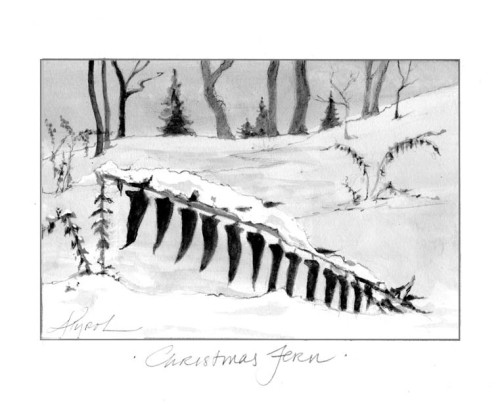
Ah, to be in the woods on a winter bluebird day. Crisp, clear, and cold, with an unimpeded view to the cloudless sky above. The sun has lifted itself out of the December doldrums and it now warms your back as you pause to soak it up. As your eyes shift down to this winter’s oddly bare ground, you may notice that a few plants are still green. Plants use green chlorophyll pigments to capture light, perform photosynthesis, and make sugars to grow and function. With all of this sun, they must be loving life!
Not so fast. For an evergreen plant holding onto its leaves, these brilliant days can be more stressful than sublime. Yes, evergreen herbs like wintergreen (Gaultheria procumbens), Christmas fern (Polystichum acrostichoides), bunchberry (Cornus canadensis) and common shinleaf (Pyrola elliptica) continue to photosynthesize when snow cover is light. But this winter feast of sunlight, after a summer subsisting on solar crumbs that trickled down through the leafy canopy above them, can cause serious biological damage if not properly managed. It’s not easy being green – especially in winter.
It’s biologically expensive to keep leaves in winter, which is why many herbs simply retreat underground, retaining only a rhizome that will produce soft, extravagant, disposable growth in the spring. Evergreen and wintergreen herbs, on the other hand, limp through the winter with leaves and photosynthetic machinery intact.
As the days shorten, evergreen plants change physically. Christmas fern and intermediate wood fern (Dryopteris intermedia) go from standing tall to lying flat, while their leaves remain very much alive. Some cells in their lower stem die, forming a ‘hinge’ which allows the fern fronds to sprawl on the ground. The fronds remain green and able to photosynthesize, and, if it’s above freezing, water and nutrients can still get to the roots. Botanists would say that the plants have become ‘rosettes’, and have documented that rosette-form plants can be up to 18 degrees Fahrenheit warmer than air just a few inches above, mostly because they are sheltered from the wind. Many arctic plants are rosettes year-round, but ferns adopt this growth form to withstand seasonally arctic conditions.
Many evergreen leaves also produce extra sugars, which lower the freezing temperature of the liquid within the leaf. For plants, this sweet strategy functionally raises the temperature at which their cells can perform photosynthesis.
Photosynthesis can only happen if the proteins within plant cells are warm enough to function, hence the aforementioned cozy strategies. Chlorophyll captures light energy from sunlight to start the process, but if the plant is too cold, things can’t proceed from there. In fact, too much light energy with nowhere to go can wreak havoc within plant cells, causing a leafy version of the free radical damage that occurs when we get bad sunburns. Plants produce their own ‘sunscreens’ in the form of antioxidant pigments: reddish or purplish anthocyanins. In winter, most leaves that stick around get redder, or ‘suntanned’ with these pigments. By protecting plant cells from sun damage, anthocyanins in plant leaves perform the same function as the melanin pigments in human skin.
While those of us who frequent the winter woods seek out south-facing slopes, evergreen herbs do the opposite. In the southeastern United States, where it gets cold but rarely snowy, these plants occur more often on north-facing slopes, which tend to be wetter as well as colder and darker in the winter. By tolerating the cold and dark, they avoid becoming brittle husks on the bright, dry southern exposures.
If holding on to your leaves in winter means you’ll have to risk cell damage from excess light or freezing, dip into your nutrient savings account to produce extra anthocyanins and sugars, and shiver out your days sprawled on cold northern slopes avoiding the precious sunlight that finally is able to hit you, why do it? Research shows that for evergreen herbs, as for many humans, winter is a time to get through rather than revel in. The real point of keeping those little, waxy, reddish-green leaves all winter is to be ready for spring, when carbon dioxide harvesting can finally catch up with the light harvesting that’s been happening through the coldest months. On the first real spring day, as the deciduous neighbors are still waking up from their long naps, stretching their rhizomes in the thawing ground, evergreen herbs can reap the rewards of patience. For them, the early leaf will get the warm.

